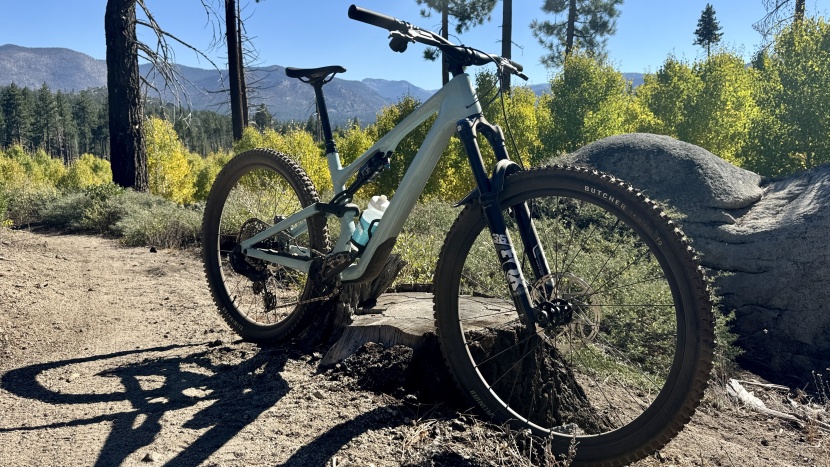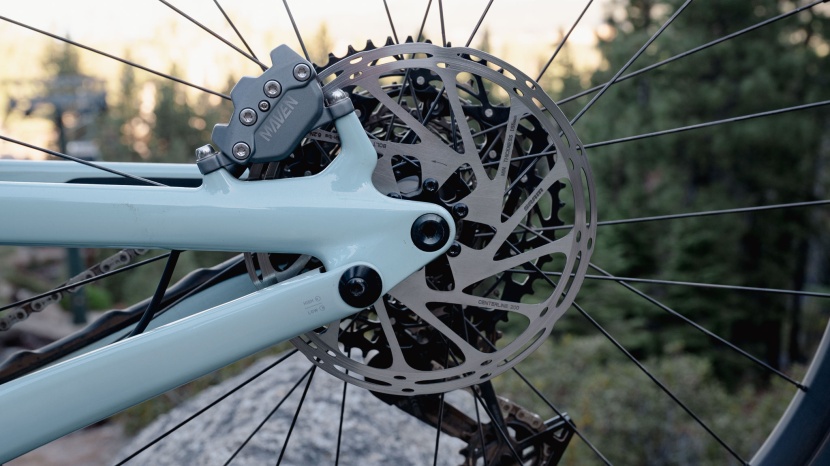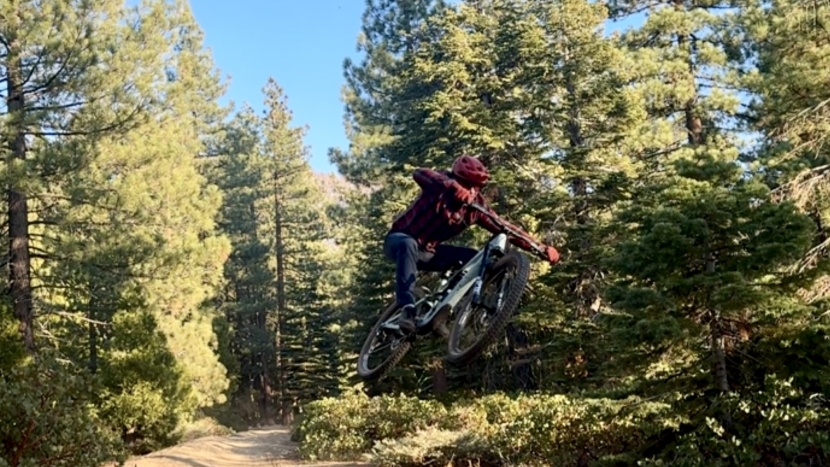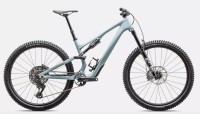Specialized Stumpjumper 15 Comp Review

Our Verdict
Our Analysis and Test Results
Should I Buy This Bike?
The 15th iteration of the famed Stumpjumper arrives with some big shoes to fill. The success of the previous generation Stumpjumper and Stumpjumper EVO had us wondering how the big S would follow suit. The Stumpjumper 15 combines those two bikes with a bit of new tech thrown in. At the top of the list is the new GENIE shock developed by Specialized in tandem with Fox. While the shock is impressive and makes for amazing graphs showing how much better this bike is, it's not a significant leap forward from the air shocks it replaces.
We can wax poetic about this bike's ride characteristics and capabilities as it truly is fantastic, but if you already have a Stumpjumper or especially a Stumpjumper EVO from the past few years, you can stop reading now. It's not that we've reached a point where bikes can't get better, but the 15 is only mildly different than the two bikes it's replacing. We loved the Stumpjumper EVO, and we will keep its review up as those bikes go on closeout. For many riders, the updates that Specialized did on this bike aren't going to be worth the new bike premium. Alright, with that out of the way, let's dive into the 15th generation of one of the sport's defining rides.
Specialized chose 145mm of travel for the bike's 4-bar rear end and paired it with a 150mm fork, although it can still be run with a 160. The FACT 11m carbon frame has an updated SWAT 4.0 downtube storage with an opening that's just about the same size but an improved access panel that is much easier to use.
Specialized makes several claims about the new Genie shock and how much it improves your ride over a standard air spring. To sum them up:
- Measurably better traction than the Stumpjumper EVO
- Linear spring rate of a coil spring through the bump zone with the progressive spring rate of an air spring at the end of the stroke.
- 16.3% better bump force management
- 57% better traction
- 39% fewer bottom-outs
Specialized writes, “This patent-pending air spring technology that we invented grants every trail rider's three wishes: the feel and control of a coil spring, better bottom-out prevention than a standard air spring, and a tunable “platform” for a playful feel.” The dual chamber shock is larger than previous shocks and allows you to fine-tune the top end and bottom end of the stroke independently. So.. how does it ride? Having put almost 3000 miles on a Stumpjumper EVO in every geometry configuration with several different shocks over the past two years, I expected a wildly different feel from the Genie, and while it's great, it's not much different. Do you notice 16.3% better bump force management? The short answer is no, while the longer answer is somewhere closer to maybe. Is the traction noticeably better? The bike feels slightly more active at the top of its stroke, giving it enhanced small bump sensitivity; that improvement in traction feels like dropping a psi or two in the rear tire. This isn't to say that the bike isn't impressive because it's truly a fantastic trail bike. As someone who rides dozens of bikes every year and spends his waking hours parsing out the performance differences of carbon vs. alloy stems or differentiating the anti-squat and anti-rise properties of different shock tunes, I'm pretty in tune with finding the nuances of performance. I won't try to refute the claims that Specialized makes above, but for the average rider, GENIE's performance isn't groundbreaking.
Frame Design
The Stumpjumper 15 isn't a radical redesign, and given the success of its predecessors, you can't blame Specialized for the small tweaks. The FACT 11m carbon tubing picks up some more angular dimensions, a front end that has more torsional rigidity, and a more streamlined, user-friendly version of the SWAT box. Gone are the flex stays on the last Stumpjumper and the offset shock with bracing arm found on the Stumpy and EVO, while the rear travel finds a happy medium at 145mm. The bike has an adjustable 3-position headset and chainstay adjustment, giving you six possible geometry configurations. There are some missing holes in the frame because the carbon version of this bike is only compatible with wireless drivetrains; this will undoubtedly cause some grumbles, but after thousands of miles on Transmission, adios cables.
To say the changes in this bike's geometry are mild is an understatement. The biggest change is moving from a 160 to a 150mm fork and slackening the seat tube by .4 degrees, both defying current trends. The headtube angle sits between 63.5 and 65 degrees, depending on how you orient the included headet top cup. The Stumpjumper EVO sat as 63-65.5 with the same headset, so the headtube angle is unchanged given the 10mm shorter fork. The bike has an effective top tube that is now 1mm shorter and a wheelbase that is 3mm shorter. The seat tube angle moves from 76.9 to 76.5, and the chainstays measure 435mm on S3 and S4 sizes. Chainstay lengths vary between sizes, with the S1 coming at 430mm and the S6 measuring 445mm, which should keep most riders appropriately positioned on the way up. With the Horst pivot in the low setting, the rear center grows 6mm, and the bottom bracket drops by 7mm to 330mm.
At 2840 grams, the new frame is 320 grams lighter than the EVO, and it no longer includes the downtube water bladder for mid-ride refills. Our only real gripe with the new frame is the rear brake mount. They chose a native 203mm mount for the rear, which means you can't use a smaller rotor. This might not have been such a sticking point, but they also spec'd this bike with SRAM's Maven brakes, the strongest in their lineup. Combining the Mavens with 200mm rotors on a trail bike is a curious choice; we felt the brakes were excessively powerful and shy of replacement; there are no options to detune their stopping power.
Design Highlights
- 29" or MX wheels with aftermarket shock link
- 145mm of 4-bar suspension
- Sram Universal Derailleur hanger
- No derailleur cable routing
- Compatible with 150mm or 160mm fork
- Adjustable headtube angle and bb height.
- 2.4" Rear tire clearance
- Frame only option for $3500 ($2300 for alloy)
- Complete bikes available with GENIE or coil shock starting at $5500
Downhill Performance
Despite having 10mm less travel than the EVO, the Stumpjumper 15 drops in with confidence and composure. The bike's calm demeanor allows you to push harder than you expect. With a 337mm bb height (in the high setting), you sit deeper into the center than most modern trail bikes, and that low center of gravity gives you significant stability. There is 1244mm between the axles, which feels about perfect; the Stumpy never felt too long in the techie sections but also kept its cool when your eyes started to water.
While the EVO seemed to come alive as your speed ramped up, the Stumpjumper 15 feels a bit more lively at slower speeds. The bike feels stable and planted, especially in rougher lines, never grasping for grip. Sprinting out of corners, you notice the front end feels a bit stiffer than previous models; there's no hint of twist in the front triangle; it's reminiscent of a Pivot frame in this sense. Despite the shock being more active, the bike feels remarkably reactive to your input; quick punches into the drivetrain produce spry acceleration. Limited anti-rise gave the bike a calm demeanor under heavy braking.
Like other 4-bar bikes, the Stumpy 15 does everything well. It might not excel deep in its stroke like a VPP bike, but the GENIE shock gives it more confidence further into its travel without finding the end of the fun meter. The GENIE also provides a more plush early stroke, giving the bike slightly better small bump compliance. Many comparisons to coil shocks have been made about this bike, but if it were truly coil-like, Specialized probably wouldn't be offering several models with actual coil shocks. That isn't to say that crushing big lines isn't its forte, as the Stumpy feels undeterred and provides stability for its suspension components. It's a stretch to say that this bike is more capable than an EVO, but it does seem to provide enhanced control.
We chose to test the Comp model, which has the same FACT 11m carbon frame as all of the carbon models, including the S-Works. The Halo bike gets a carbon shock link, while all others in the lineup use an aluminum link; otherwise, the frames are identical. Our bike was spec'd with a Fox Float 36 Rhythm fork with 150mm of travel and a GRIP damper. This damper is relatively basic, but the chassis is solid and provided an accurate feeling front end that didn't falter in the bigger lines or bad landings. The shock is the Fox Float Performance with Specialized GENIE Ride Dynamics trail tune and a two-position lever with low-speed rebound dampening. Much has been written about this shock, but on the trail, it doesn't feel radically different than a Fox Float X. Like the newer Fox Grip X damper, the GENIE makes a bit more noise, kinda like a squirrel making ninja noises, but you quickly get used to it. The suspension feels well-matched and complimentary; with the bike set up properly, we never felt that it was lacking or that there was an adjustment we were missing.
Featuring the new SRAM S1000 Transmission group, the AXS-equipped shifting was flawless and, from the cockpit, felt no different than the GX or XX groups that we're testing on other bikes. All AXS groups use the same AXS shift pod, but this bike uses the SRAM XS-1270 cassette that mates to an HG freehub body, so upgrading it without upgrading your wheel or freehub body isn't possible. The cassette had zero performance issues, but it's 215 grams heavier than a higher-end model. The bike rolls on Specialized alloy wheels with 30mm rims and sealed bearing hubs; they do their job and provide sufficient engagement, but they're otherwise unremarkable. A Specialized Butcher GRID TRAIL T9 tire up front and Eliminator, GRID TRAIL T7 in the rear are amongst the best stock tires around. They claw for grip, and the tread pattern gives near-perfect connection in most conditions. We found the braking traction from both front and rear outstanding, but the rear was prone to skidding from the overpowered brake setup. We started testing this bike mid-summer in the Eastern Sierras on soil with a high percent of decomposed granite, which can give it a soft, kitty litter texture, so we swapped out the 2.3" rubber for 2.5" for a bit more levitation.
SRAM Maven Bronze brakes are phenomenal but an odd choice for this bike. On the one hand, more braking power means less hand fatigue, but paired with 203mm rotors, the brakes are too much for the bike. We love the brakes, but all of our testers agreed that we'd swap for smaller rotors (not possible), at the very least in the rear. Despite having too much power, the bike's limited anti-rise keeps the rear end active while you're on the brakes.
The cockpit is at once unremarkable and perfect; Specialized does a great job with its basic cockpit specs. 800mm alloy bars with 30mm of rise connect to their 40mm alloy trail stem using a 35mm clamp. This gave us precise, predictable steering but less vibration dampening than we'd like in the long term. A carbon bar was a welcome addition to this bike as we reached the end of testing. The X-Fusion Manic dropper gave us 170mm of drop on our S4 test bike, and the 143mm Bridge Comp saddle was great to sit on and easy to get behind. The S1 gets a 125mm dropper, the S2 gets 150mm, and the S6 gets the long 190mm dropper post. The S1 and S2 sizes also get the wider 155mm saddle.
Uphill Performance
The Stumpjumper 15's uphill performance doesn't feel revolutionary. This isn't the dawn of new geometry or some newly updated major industry standard. Compared to the EVO, this bike loses a single millimeter of top tube, and its wheelbase shrinks by just 3mm. This is a case of not fixing things that aren't broken; this bike climbs with an athletic vigor. It feels sporty and reactive when you're on the gas, making you think it won't descend as well as it does like those performance aspects can't co-exist.
The Stumpy never felt like it was too aggressive or too much bike. Even when riding a neighborhood jogging trail or goofing off at the bike park, the bike feels like it isn't compromising any performance attribute. The 4-bar rear end is well-mannered, and the GENIE shock, despite its mildly plusher initial stroke, has sufficient anti-squat that you're never wallowing in the travel like you might on an actual coil shock. It's important not to gloss over how well modern trail bikes climb; for the most part, all of the modern trail geometry bikes climb incredibly well, with the worst new bikes being better than the best bikes from 6-7 years ago. The Stumpjumper's 76.5-degree seat tube angle is authoritative; you're perched for power, and the frame and suspension come together for excellent power transfer, traction, and efficiency.
The 150mm fork on this bike gives it a 64.5-degree headtube angle in the middle headset setting. Swapping out to a 160mm fork pulls you back to about 64 degrees, where the steering starts to feel less than ideal in technical climbing. The front end has a Goldilocks feel, and despite generally running longer forks, I'm inclined to leave the front end at 150. Testers remarked that the bike felt energetic, quick, and “with magnetic traction.” We also ran the headtube in its slackest setting using the swappable top headset cup, netting us a 63.5-degree front end for a mini-enduro feel. While it made for fearless descending, the bike lost much of its playfulness and ascending chops.
While the new frame is lighter, the rest of the changes to the Stumpjumper didn't make the bike any lighter; our test bike weighed in at 32 pounds, 9 ounces. That's less than its claimed weight, but even the halo S-Works model barely dips below 30 pounds. This is partly due to the heavier Transmission drivetrain and monstrous brakes, but weight creep is real. How much the weight of a trail bike matters is a contentious topic, but I can tell you its effect on the Stumpjumper 15's climbing abilities is minimal. A reasonably steep seat tube angle and 475mm of reach puts you in a powerful position with plenty of space to open up and breathe in the cockpit. A wheelbase of 1244 would have been considered exceptionally long just a few years ago but now sits in the middle of the spectrum. The length of this bike allows you to sit inside between the axles in all but the steepest grades, and it still feels relatively agile in low-speed, tight technical moves. Deviating from the neutral geometry setup nets big changes; the bottom bracket in the low setting is a pedal dragging 330mm. Cornering at this height is exhilarating as your center of gravity drops deep below the axles. Pedaling at this height can be treacherous and not for the faint of heart, especially in rocky or rooty conditions.
Ease of Maintenance
Most modern full-suspension bikes can go a couple of seasons without significant frame maintenance, but exceptions exist. Since this frame is new, we can't say how durable it will be or how long you can go between servicing pivots. It is, however, structurally very similar to the outgoing Stumpjumper EVO on which we've put thousands of trouble-free miles. Using the same sealed bearing pivots and linkage as its predecessor gives us confidence, as does Specialized's “lifetime no-questions-asked” warranty policy on pivot bearings. While the chainstay pivots on the 4-bar linkage are susceptible to wear and misalignment, this hasn't been an issue for the past few iterations of the Stumpy.
The bike's build kit also feels relatively easy to maintain. If you're anxious about electronic shifting, your fears are likely unfounded. The rechargeable AXS battery lasts for weeks of daily riding and takes only a couple of hours to recharge. The CR2032 battery in the AXS shifter pod lasts for at least an entire season of riding. The upside of electronic shifting is never experiencing cable stretch, broken ferrules, or frayed cables again. Once the Transmission drivetrain is set up, it never needs to be adjusted, and we've been getting about 1000 miles out of Transmission chains. The new drivetrain also ditches the derailleur hanger, which has been an Achilles heel hanging off the lowest part of our bikes for too long. We had reservations about the “low-end” Transmission that uses a new drag-spring clutch instead of the overload clutch used on their fancier derailleurs. While it weighs a bit more, the performance is outstanding, and after several hundred miles, the only complaint we can muster is that the cassette sits on an HG freehub body.
The wheels aren't a highlight of this bike, but as with the cockpit, Specialized nails the basics, and they don't distract from the bike's performance. 28-hole alloy rims with hookless 30mm internal width and sealed bearing hubs don't have any real faults, but they don't stand out, and the difference we felt when running RaceFace ERA or Enve M6 carbon wheels on this bike was remarkable. We put the wheels in the truing stand at the end of testing and had to twist a few nipples. We noticed impact damage to the rear rim, but it didn't result in air or sealant loss, and the tire's sidewall was unscathed.
Photo Tour
Value
The Stumpjumper 15 Comp build we tested sells for $5500, which feels like a solid value. That said, there are some incredible values in the mountain bike market, and there are deals to be had. If you don't need the latest and greatest, shop the Stumpjumper EVO, which offers a very similar ride at last year's prices. The range-topping LTD version of this bike sells for $13,500 with Fox live valve suspension, while the base alloy model sells for $3000. At the time of publication, Specialized offers six carbon and three alloy models, including three with coil shocks and frames in either frame material. Before testing, we would have thought the Expert model, using the GX Transmission group, would be the sweet spot of the lineup, but we liked the S1000 and Performance suspension so much that this is the bike of our choice. If you can spend some extra cash, we'd recommend buying this bike and upgrading the wheels and cassette.
Conclusion
While the updates to the Stumpjumper 15 all seem minor, they give way to a remarkably adept trail bike with all of the benefits of modern bike technology. The GENIE shock doesn't feel revolutionary, but the increased traction it provides is spectacular. With adjustable geometry and the ability to run a 160mm fork, this bike is wildly versatile and can excel in almost any terrain. If it's new bike time, give the 15 a spin; it's a highly refined ride that is thoroughly impressive. If being on the latest and greatest is less important to you, give the last-gen Stumpjumper EVO a spin; there will likely be outstanding deals on that bike.
| Awards | |
|---|---|
| Price | $5,500 List |
Overall Score  |
|
| Star Rating | |
| Bottom Line | This phenomenal trail bike incorporates almost everything we could ask for, but it's not significantly different from the outgoing Stumpjumper EVO |
| Pros | Genie shock, Upgraded frame storage, Adjustable geometry |
| Cons | 200mm native rear brake, Only minor changes from past model |
| Rating Categories | Specialized Stumpjum... |
| Fun Factor (25%) | |
| Downhill Performance (35%) | |
| Climbing Performance (35%) | |
| Ease of Maintenance (5%) | |
| Specifications | Specialized Stumpjum... |
| Wheel size | 29" or MX |
| Suspension & Travel | FSR - 145mm |
| Measured Weight (w/o pedals) | 32 lbs 9 oz (S4) |
| Fork | Fox 36 Float Rythym 150mm |
| Shock | FOX FLOAT Performance with Specialized GENIE |
| Frame Material | Carbon Fiber |
| Frame Size | S4 (Large equivalent) |
| Frame Settings | Headtube Nagle |
| Available Sizes | S1-S6 |
| Wheelset | Specialized 30mm, Alloy hubs |
| Front Tire | Specialized Butcher GRID TRAIL T9, 2.3" |
| Rear Tire | Specialized Eliminator GRID TRAIL T7, 2.3" |
| Shifters | SRAM AXS Pod |
| Rear Derailleur | SRAM S1000 |
| Crankset | SRAM S1000 170mm 32T |
| Saddle | Specialized Bridge Comp |
| Seatpost | X-Fusion Manic 190mm (S4/S6), 34.9 diameter |
| Handlebar | Specialized 6061 alloy, 30mm rise, 800mm width |
| Stem | Specialized Alloy Trail stem, 35mm bore |
| Brakes | SRAM Maven Bronze |
| Measured Effective Top Tube (mm) | 624 |
| Measured Reach (mm) | 475 |
| Measured Head Tube Angle | 63.5-65-degree (adjustable) |
| Measured Seat Tube Angle | 76.5-degrees |
| Measured Bottom Bracket Height (mm) | 337 H / 330 L |
| Measured Wheelbase (mm) | 1244 |
| Measured Chain Stay Length (mm) | 435 (S3-S4) |
| Warranty | Lifetime |




















